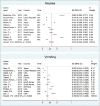Prevalence of postoperative nausea and vomiting: A systematic review and meta-analysis
- PMID: 31998020
- PMCID: PMC6970369
- DOI: 10.4103/sja.SJA_401_19
Prevalence of postoperative nausea and vomiting: A systematic review and meta-analysis
Abstract
Objective: Postoperative nausea and vomiting (PONV) is a daily phenomenon, to which less attention has been paid in a variety of surgeries. Despite the individual studies, there is no comprehensive study on the prevalence of PONV. The aim of this study was to determine the global prevalence of PONV.
Materials and methods: In this systematic and meta-analysis study, descriptive studies of four databases (PubMed, Web of Science, Scopus, and Google Scholar) were searched for relevant texts from the time they were created until 31 December 2018. The random effects model was used for meta-analysis of studies included. All the steps were carried out by two individuals. Hoy et al.'s tool was used to evaluate its risk bias.
Results: A total of 23 studies that were performed on 22,683 people from 11 countries were entered into the final phase. The prevalence of PONV, nausea, and vomiting was 27.7%, 31.4%, and 16.8%, respectively. The prevalence of PONV was higher during the first 24 h in European countries.
Conclusion: Considering the high prevalence of PONV and our goal to better control it, it is necessary to use high cost-effective approaches and recommendations and to educate health caregivers and patients.
Keywords: Meta-analysis; postoperative nausea and vomiting; prevalence; surgery complications.
Copyright: © 2020 Saudi Journal of Anesthesia.
Conflict of interest statement
There are no conflicts of interest.
Figures





References
-
- Dolin S, Cashman J, Bland J. Effectiveness of acute postoperative pain management: I. Evidence from published data. Br J Anaesth. 2002;89:409–23. - PubMed
-
- Apfel C, Heidrich F, Jukar-Rao S, Jalota L, Hornuss C, Whelan RP, et al. Evidence-based analysis of risk factors for postoperative nausea and vomiting. Br J Anaesth. 2012;109:742–53. - PubMed
-
- Gan TJ, Meyer TA, Apfel CC, Chung F, Davis PJ, Habib AS, et al. Society for ambulatory anesthesia guidelines for the management of postoperative nausea and vomiting. Anesth Analg. 2007;105:1615–28. - PubMed
-
- Kovac AL. Update on the management of postoperative nausea and vomiting. Drugs. 2013;73:1525–47. - PubMed
LinkOut - more resources
Full Text Sources
Medical
Miscellaneous

